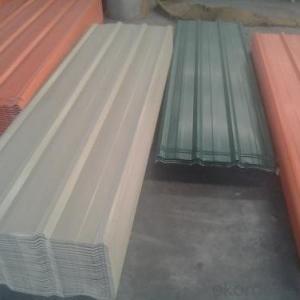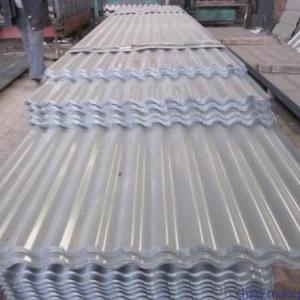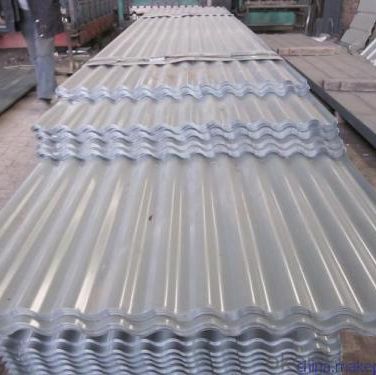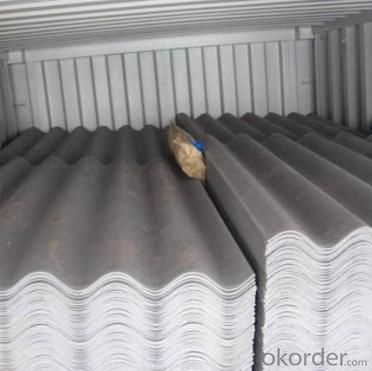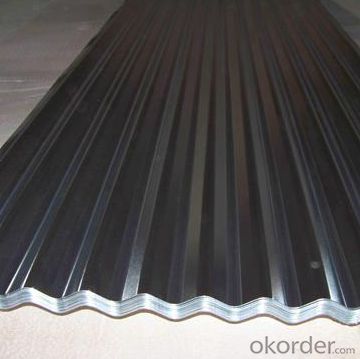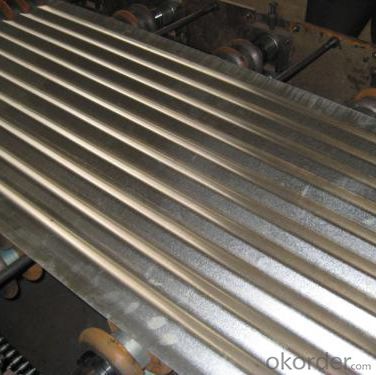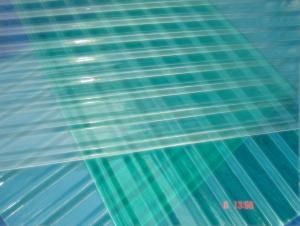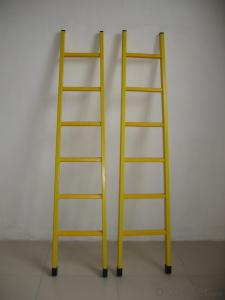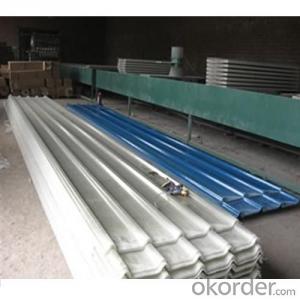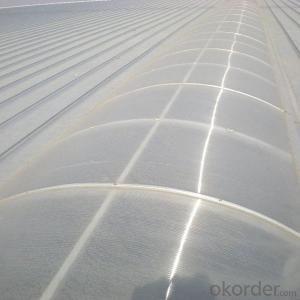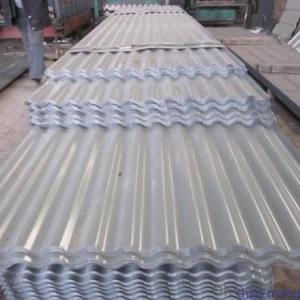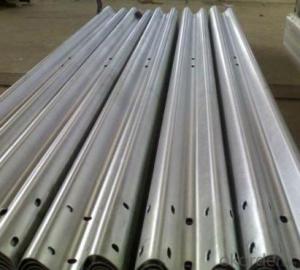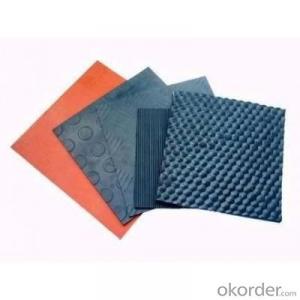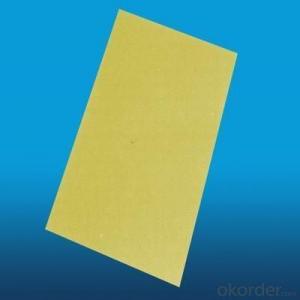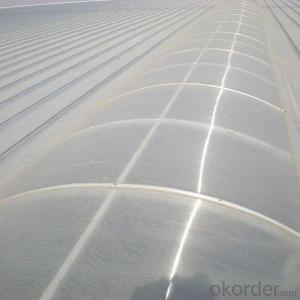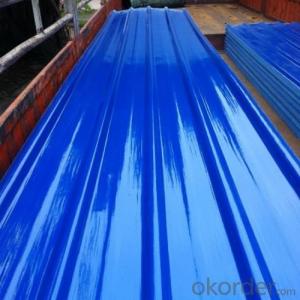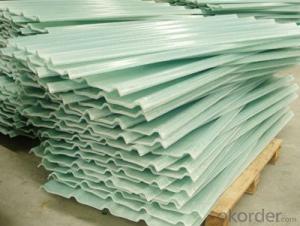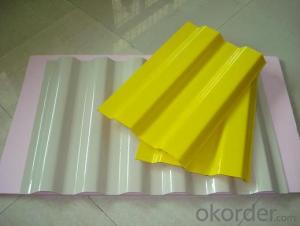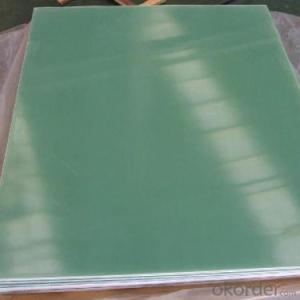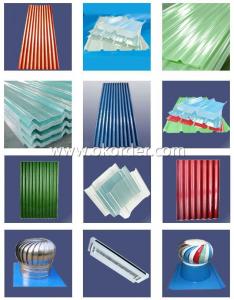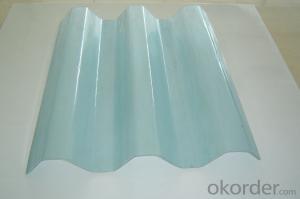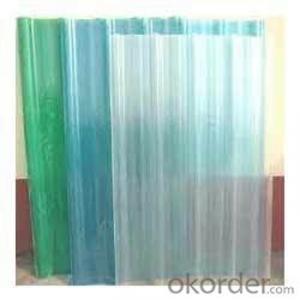FRP Roofing Panel - Fiberglass Roofing Sheet Material Tile
- Loading Port:
- Tianjin
- Payment Terms:
- TT OR LC
- Min Order Qty:
- 300 m
- Supply Capability:
- 40000 m/month
OKorder Service Pledge
OKorder Financial Service
You Might Also Like
Specification
PRODUCT DESCRIPTION
FRP GRP Fiberglass Glassfiber Corrugated Roofing is a patent of our company, not like other FRP products, it is produced without yarn, instead, we use mat only. Therefore, the corrugated sheet is more strong in both horizontal and vertical direction.
Cold rolled sheet has superb sheet shape and surface quality with good flatness and surface finish. The surface of the cold sheet is clean and bright and easy for coating. The varieties of cold rolled sheet are widely used in galvanized substrates, home appliances, tubing, automobiles, building, enamels and other industries.
FEATURES
a. anti-corrosion, non-rusty
b. lightweight and high strength
c. anti-flammable
d. anti-fatigue
e. anti-slippery and safety
f. anti-ageing
g. easy to installation and maintenance
h. excellent electromagnetism property
SPECIFICATIONS
Thickness | Mesh size | Panel size | Open area | Weight |
(MM) | (MM) | (MM) | % | (kg/m2) |
25 | 38*38 | 1220*3660 | 68 | 12.5 |
1220*4076 | ||||
1220*4000 | ||||
30 | 38*38 | 1220*3660 | 68 | 14.75 |
1220*4000 | ||||
38 | 38*38 | 1007*4047 | 68 | 19.5 |
1220*3660 | ||||
1220*4000 | ||||
50.7 | 50.7*50.7 | 1220*3660 | 71 | 23.5 |
1220*4000 | ||||
30 | 19*19 | 1007*4007 | 40 | 18.1 |
38 | 19*19 | 1007*4007 | 40 | 23.5 |
PICTURES
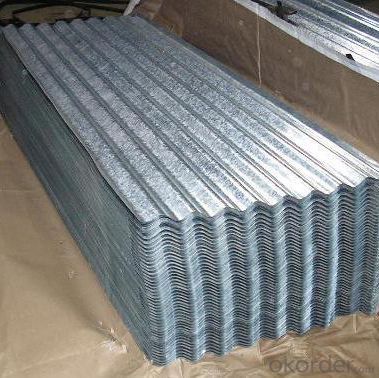

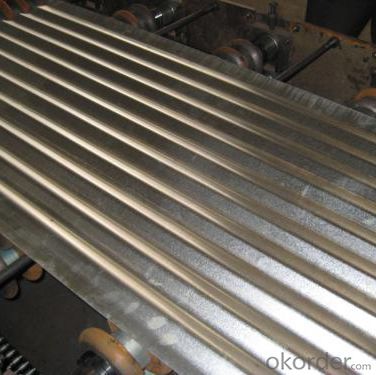
- Q: Can FRP roofing panels be used for residential garages or carports?
- Yes, FRP (Fiberglass Reinforced Plastic) roofing panels can be used for residential garages or carports. They are lightweight, durable, and resistant to UV rays, making them a suitable choice for protecting vehicles in these spaces. Additionally, FRP panels are low-maintenance and can provide good insulation and natural lighting options.
- Q: Are FRP roofing panels suitable for high wind areas?
- Yes, FRP (Fiberglass Reinforced Plastic) roofing panels are suitable for high wind areas. FRP roofing panels are known for their exceptional strength and durability, making them highly resistant to strong winds. The fiberglass reinforcement in the panels provides added structural integrity, allowing them to withstand the forces exerted by high winds without becoming damaged or dislodged. Additionally, FRP roofing panels are designed to be securely fastened to the roof structure, further enhancing their ability to resist wind uplift and maintain their integrity in high wind areas.
- Q: Can FRP roofing panels be customized in terms of size and shape?
- FRP roofing panels are capable of being tailored to fit specific size and shape requirements, offering a high level of customization. These panels are produced by combining fiberglass and resin, resulting in a design that allows for flexibility. By cutting and shaping the panels, they can be adjusted to accommodate the precise dimensions and angles needed for any roofing project. This versatility in customization makes FRP roofing panels an excellent choice for a range of architectural and construction applications, regardless of the project's scale.
- Q: Can FRP roofing panels be used in military or government buildings?
- Military or government buildings can indeed utilize FRP (Fiberglass Reinforced Plastic) roofing panels. These panels offer a multitude of advantages that make them ideal for these types of structures. Firstly, they possess exceptional durability and resistance against impacts, corrosion, and chemical damage. As a result, they are well-suited for military and government buildings that may face harsh environmental conditions or potential attacks. Additionally, the lightweight nature of FRP panels proves advantageous for installation purposes. They are easy to handle and transport, facilitating quicker and more efficient construction or renovation of military or government facilities. Another crucial benefit of FRP roofing panels lies in their outstanding insulating properties. They effectively regulate temperature and minimize energy consumption, leading to reduced heating and cooling costs for these buildings. This is particularly vital for government buildings, where energy efficiency and sustainability often take precedence. Moreover, FRP panels offer versatility and can be tailored to meet specific requirements. They come in various colors, finishes, and profiles, allowing for design flexibility and aesthetic appeal. This is especially advantageous for military or government buildings that may necessitate specific branding or architectural specifications. In summary, due to their durability, lightweight nature, insulation capabilities, and customization options, FRP roofing panels are a suitable choice for military or government buildings.
- Q: Are FRP roofing panels suitable for museums or art galleries?
- Depending on various factors, FRP roofing panels may be suitable for use in museums or art galleries. They have several advantages that make them a popular roofing choice in different settings. To begin with, the lightweight nature of FRP panels makes them easy to install and reduces the burden on the building structure. This is particularly advantageous for museums or art galleries with delicate artworks, as it minimizes the risk of damage during installation. Moreover, FRP panels are highly durable and resistant to weathering, UV radiation, and corrosion. This makes them ideal for safeguarding valuable collections in museums or art galleries from potential harm caused by external elements. Additionally, FRP panels possess excellent light transmission properties, allowing natural light to enter the building and creating a bright and inviting atmosphere for visitors. This is especially crucial in museums or art galleries where proper lighting is essential for displaying artwork or exhibits. Furthermore, FRP panels can be customized to meet specific design requirements. They are available in various colors, finishes, and textures, providing flexibility in creating visually appealing roofing systems that complement the architectural style of the museum or art gallery. However, before determining the suitability of FRP roofing panels, it is vital to consider the specific needs and conditions of the museum or art gallery. Factors such as location, climate, and architectural design should be taken into account to ensure that the panels can provide adequate insulation, ventilation, and protection against potential hazards. In conclusion, FRP roofing panels can be a viable option for museums or art galleries. Their lightweight nature, durability, light transmission properties, and customization options make them suitable for protecting valuable collections while creating an aesthetically pleasing environment for visitors. However, it is crucial to assess the specific requirements of each facility to determine if FRP panels are the best choice.
- Q: Are FRP roofing panels prone to fading or discoloration?
- FRP (Fiber Reinforced Plastic) roofing panels are generally resistant to fading and discoloration. The panels are designed to withstand UV exposure and are often coated with protective layers that prevent color fading over time. However, it is important to note that prolonged exposure to harsh sunlight and extreme weather conditions can still cause some level of fading or discoloration over an extended period. Regular maintenance and proper care, such as cleaning and applying protective coatings, can help minimize any potential fading or discoloration. Overall, FRP roofing panels are known for their durability and resistance to fading, making them a reliable choice for long-lasting roofing solutions.
- Q: Can FRP roofing panels be used in historical preservation projects?
- Yes, FRP roofing panels can be used in historical preservation projects. These panels are lightweight, durable, and resistant to corrosion, making them suitable for protecting historical buildings while maintaining their original aesthetic. Additionally, FRP panels can be customized to mimic the appearance of traditional roofing materials, ensuring a seamless integration with the historical architecture.
- Q: Are FRP roofing panels resistant to damage from pests or rodents?
- FRP (Fiberglass Reinforced Plastic) roofing panels are generally resistant to damage from pests or rodents. The composition of FRP panels, which typically consists of a fiberglass layer reinforced with a plastic resin, makes it difficult for pests or rodents to chew or gnaw through the material. Additionally, FRP panels are often installed with tight seals and fasteners, minimizing opportunities for pests or rodents to gain access to the roof structure. However, while FRP roofing panels are resistant to damage, it is important to note that they are not entirely impervious to pests or rodents. In rare cases, determined rodents may still find a way to cause damage by burrowing or digging through weak points in the roofing system. Therefore, it is essential to regularly inspect the roof for any signs of pest or rodent activity and take appropriate measures to address them promptly. To further enhance the resistance against pests or rodents, additional measures can be taken, such as applying pest deterrents or installing mesh barriers at vulnerable areas, like vents or openings. Consulting with a professional roofing contractor or pest control expert can provide valuable guidance on the best practices to protect FRP roofing panels from pests or rodents.
- Q: Do FRP roofing panels have any special fire rating certifications?
- Yes, FRP (Fiberglass Reinforced Plastic) roofing panels can have special fire rating certifications. The fire rating of FRP roofing panels is determined by various factors such as the type of resin used, the thickness of the panel, and the presence of fire-retardant additives. To ensure the safety and compliance of FRP roofing panels, they undergo rigorous testing and evaluation to obtain fire rating certifications. The most common fire ratings for FRP panels include Class A, Class B, and Class C. Class A fire-rated FRP panels are the most fire-resistant and have the highest level of protection. They are designed to resist severe fire exposure and have low flame spread and smoke development. These panels are typically used in applications where fire safety is of utmost importance, such as commercial buildings, hospitals, and schools. Class B fire-rated FRP panels offer moderate fire resistance and are suitable for applications where a higher level of fire protection is required but not as critical as Class A. They have a moderate flame spread and smoke development rate. Class C fire-rated FRP panels provide the lowest level of fire resistance. While they still offer some level of protection, they are not suitable for applications where fire safety is a top concern. These panels have a higher flame spread and smoke development rate compared to Class A and B. It is essential to check the fire rating certifications of FRP roofing panels before selecting them for a specific application. These certifications ensure that the panels meet the required fire safety standards and provide adequate protection against fire hazards.
- Q: Are FRP roofing panels suitable for outdoor recreational structures?
- Yes, FRP (Fiberglass Reinforced Plastic) roofing panels are suitable for outdoor recreational structures. FRP panels are known for their durability, strength, and resistance to various weather conditions. They are lightweight, easy to install, and have a long lifespan, making them ideal for outdoor structures such as gazebos, pergolas, and pavilions. One of the key advantages of FRP roofing panels is their resistance to UV radiation. They have a protective gel coating that prevents them from fading or yellowing when exposed to sunlight. This makes them perfect for outdoor recreational structures that are constantly exposed to the elements. Furthermore, FRP panels are highly resistant to corrosion and moisture, making them suitable for areas with high humidity or near coastal regions. They do not rust or rot like traditional roofing materials, which enhances their longevity and reduces maintenance costs. Additionally, FRP panels are available in various colors, styles, and textures, allowing you to choose the one that best suits the aesthetic of your outdoor recreational structure. They can also be translucent, allowing natural light to filter through while providing protection from harmful UV rays. In conclusion, FRP roofing panels are a suitable choice for outdoor recreational structures due to their durability, resistance to weather conditions, and aesthetic options. They provide a long-lasting solution that requires minimal maintenance, making them an excellent investment for any outdoor recreational project.
Send your message to us
FRP Roofing Panel - Fiberglass Roofing Sheet Material Tile
- Loading Port:
- Tianjin
- Payment Terms:
- TT OR LC
- Min Order Qty:
- 300 m
- Supply Capability:
- 40000 m/month
OKorder Service Pledge
OKorder Financial Service
Similar products
Hot products
Hot Searches
Related keywords
